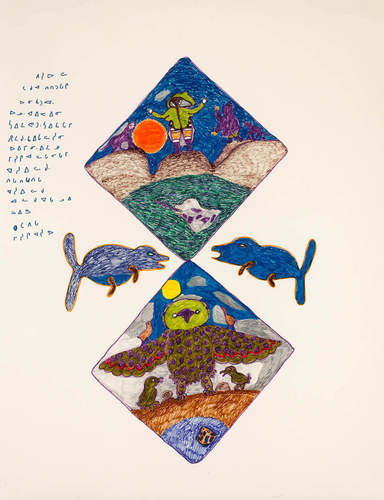Pitseolak Ashoona (c.1904–1983) occasionally drew on the legends she heard in her youth, particularly from her father, Ottochie. This gem-like drawing has all the hallmarks of her work—Inuit and animals in a landscape setting, portrayed in rich colour and using a vibrant line.

Pitseolak Ashoona, Legend of the Woman Who Turned into a Narwhal, c.1974
Coloured felt-tip pen on paper, 66 x 50.7 cm, National Gallery of Canada, Ottawa
The scene in the upper part of the drawing depicts a critical moment in the story of a woman who becomes a narwhal. There are several versions of the tale, but Pitseolak’s may be a variation from Nunavik (Arctic Quebec), where her father’s family originated, with her own personal emphasis. Along the side she writes the following in syllabics: “These are Pitseolak’s drawings. Every few days she would manage to be patient enough from the beatings she received from her husband. One day by the sea she was about to be beaten again. So she prepared to jump into the sea. At that moment all the narwhals rose to the surface of the water in front of her.”
To escape her husband’s abuse, the woman jumps off a cliff; she does not die but is instead transformed into a narwhal. Pitseolak depicts the moment of transformation that saves the woman, with her long braid twisting into a tusk.
Pitseolak retells a legend in her drawing, but her focus on this version of the story is a rare instance of her depicting one of the hardships that she and many other women faced in camp life.
This Spotlight is excerpted from Pitseolak Ashoona: Life & Work by Christine Lalonde.
 Pyramid Scheme
Pyramid Scheme
 Transportive Trunks
Transportive Trunks
 The Military Mate
The Military Mate
 Looking Up on the World
Looking Up on the World
 Vessel of Despair
Vessel of Despair
 Layers of Meaning
Layers of Meaning
 In Parallel to Nature
In Parallel to Nature
 Wheel of Fortune
Wheel of Fortune
 Paintings after emotional states
Paintings after emotional states
 Garden of Delight
Garden of Delight
 Stitching the Archives
Stitching the Archives
 A Working-Class Hero
A Working-Class Hero
 Imagining Entangled Futures
Imagining Entangled Futures
 Bridging Far and Near
Bridging Far and Near
 Soft Power
Soft Power
 Imagining Emancipation
Imagining Emancipation
 A Priceless Portrait
A Priceless Portrait
 Meditation in Monochrome
Meditation in Monochrome
 Making His Mark
Making His Mark
 Honour and Sacrifice
Honour and Sacrifice